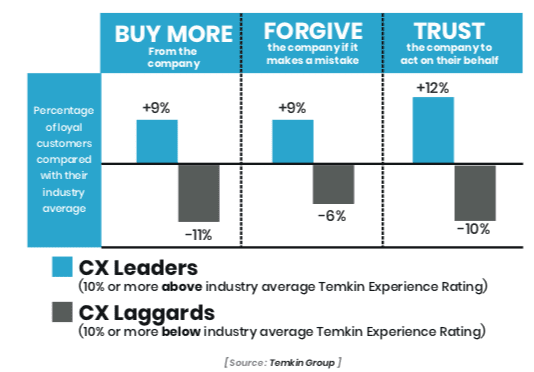If you haven’t worked it out yet, we’re big advocates of creating an exceptional customer experience. In fact we’re so committed to it, we’ve made it our business to help yours deliver a better experience for your customers through well-designed systems and processes.
So what is the “customer experience economy”?
While the term has been around for a couple of decades, it has gained more traction in recent years as customer-seller interactions shift, from a focus on the product only, to the product and the service, with the latter taking a much higher priority. Regardless of whether you offer a hard product, or a service-based one; whether your price point is in cents or thousands of dollars per unit; whether it’s a one-off transaction, or an ongoing relationship. Your customers are choosing to do business with you because of the service you provide – before, during and after their purchase.
One analogy that’s commonly used to help describe the customer experience economy is something we can all relate to: coffee. We all know perfectly well how much it really costs to make a cup of coffee, yet millions of us are prepared to spend $4-5 a cup, every day. Why? Because of how much we value the customer experience – the regular interaction with friendly café staff who remember our order, the style and atmosphere of the café… Ultimately, it’s the sense we get of how much they value us as people, not just another sale.
Are you a leader or a laggard?
Getting people’s attention amid all the advertising noise and barrage of product choices can be hard (and expensive) work, and with very little difference between most of these offerings, it’s a lot harder to make a buying decision.
Companies that understand what metrics like ‘costs to acquire’ and ‘cost to retain’ mean to their bottom line are quick to adopt the core principles of creating a valuable customer experience. And it’s these companies that are leading the customer experience economy transformation, by recognising their customers’ needs are changing – from being treated as just another notch on the sales board, to a person who is looking for a solution to a need or challenge – and finding the most effective way to meet them.
Business that are slower to respond – the laggards – are those that will struggle to hold their market share, if they’re not struggling already.
The three major advantages that leaders in the customer experience economy enjoy is that they earn much more trust equity with their customers, with the effect that they tend to buy more, and be more forgiving when a business makes a mistake.
 Figure 1 Source: https://www.digitaldoughnut.com/articles/2019/june/the-customer-experience-economy, citing Temkin Group.
Figure 1 Source: https://www.digitaldoughnut.com/articles/2019/june/the-customer-experience-economy, citing Temkin Group.
Staying relevant to your clients and customers
In a recent report, US-based research firm, UserTesting, stated that for businesses to stay competitive in the customer experience economy, they had to “…keep up with the pace of customer expectations (and) continually leverage the right tools, resources, and processes.”[1]
The key term being: “right”. At Premier Contact Point, we take a holistic approach to helping contact centres identify what “right” means for them, their commercial and operational goals, and the targets they’re trying to achieve for their clients. The reward is a level of customer connection and loyalty that returns far and above your investment in time and money, not to mention marketing ROI.
The customer experience economy is a distillation of all the different interactions your customers have with a business. These touch points aren’t just about the direct contact they have with you, but happen behind the scenes, and in the general market place. (For example, think of the disconnect a customer may feel when they see a campaign that offers new customers an introductory rate that’s lower than what they’ve been paying as a “loyal customer” for the past five years.)
There are a lot of factors to think of when plotting your business’s customer experience evolution, and it can get overwhelming. To overcome this, get laser-clear on scope. What does a good customer experience look like for your company? What does the evolution mean for your business, your team, your customers? Remember, slow and steady wins the race. The market is changing all the time, and so are the resources and solutions. Target your customers’ top priorities, and identify any quick wins that will help people better understand the journey you’re taking them on.
Keep communication lines open with all your stakeholders – suppliers and staff as well as active and prospective customers – so they feel a part of the process. Their feedback will be vital in helping you gauge whether your changes are happening too fast, or too slow; whether you’re starting to stray off track, or if you’re right on the money.
Agility and adaptability must be built-in
As the saying goes, the only constant is change. These days it’s happening faster than we can anticipate. So it’s vital to build in a level of adaptability into your systems and processes that will let you respond quickly to changing trends as they emerge – without compromising your current service or alienating customers. Regardless of what the broader research says – and there’s a lot of it out there – the most important thing is to know what matters most to your own customers. Asking the right questions of them, and listening to their responses, will keep you at the forefront of competitiveness in your own sector.
[1] “The rise of the experience economy”, UserTesting, 2019, p.5.
Become a CX Economy Leader with Premier Contact Point
Don’t let your business lag behind when it comes to gaining advantages in the marketplace. Our team can help identify how you can leverage our class-leading customer contact technology in ways that are right for your organisation – so you can start winning in the Customer Experience Economy.
